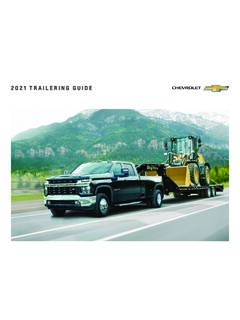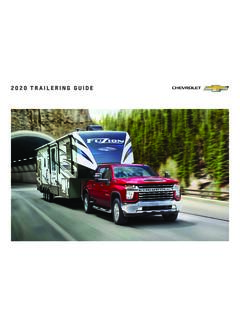Transcription of GUIDE TO TYRE MANAGEMENT ON HEAVY VEHICLES
1 GUIDE TO TYRE MANAGEMENT ON HEAVY VEHICLESFORWARD BY THE SENIOR TRAFFIC COMMISSIONER FOR GREAT BRITAINI am delighted to endorse this important document as traffic commissioners need to be assured that operators follow best practice, in addition to meeting minimum legal GUIDE sets out industry-recognised best practice regarding tyre maintenance on HEAVY VEHICLES . It offers a wealth of advice to operators about tyre choice, maintenance and safety, including consideration about the physical condition and age of tyres. I am sure that many operators will learn a lot from the would like to record my personal thanks to the North West LGV and PCV Maintenance Liaison Committees who took the work on with enthusiasm and commitment. In doing so they worked with the representative bodies of the tyre and operating specialist regulators, traffic commissioners promote operator licence compliance, which is based on the twin principles of road safety and fair majority of the industry operates well above the minimum standards and I know that this document will support operators and drivers in having access to information that will continue to promote best BELL Senior Traffic Commissioner for Great BritainDocument first published October 2015 First review scheduled October 2016 CONTENTS1.
2 INTRODUCTION 12. TYRE MANAGEMENT system 13. TYRE CHOICE AND FITTING 24. TYRES IN SERVICE 55. TYRE REPAIRS 96. REGROOVING 97. RETREADING 108. TYRE STORAGE 119. WHEELS 1110. TRAINING 1111. ACKNOWLEDGEMENTS 1312. USEFUL CONTACTS 131. INTRODUCTIONThis GUIDE contains essential information necessary to the safe and efficient MANAGEMENT of tyres fitted to HEAVY VEHICLES : trucks, trailers, buses and coaches. It is addressed to vehicle operators in the UK and reflects UK regulations and operating conditions. The guidance may not be applicable in countries outside the UK. Equally, not all the advice may be applicable to specialist VEHICLES such as cranes or mobile are a safety critical element of every vehicle on the road. They are also one of the most highly regulated automotive components. Tyre manufacturers exercise great care in producing safe, reliable and compliant products. However, the manufacturer cannot accompany a tyre throughout its life; the vehicle operator is responsible for the tyre s in-service condition.
3 This responsibility is backed by legal obligations concerning not only the condition of the tyre but also the processes and procedures in place to ensure that tyres in use are fit for purpose at all TYRE MANAGEMENT SYSTEMA robust tyre MANAGEMENT system is essential for any professional vehicle operator and should ensure: That tyres in service are appropriate to the vehicle and operating conditions; That vehicle tyres are regularly and closely examined for damage and wear with mechanisms in place to address any identified issues; That processes exist to distribute best practice in tyre MANAGEMENT throughout the fleet; That staff dealing with tyre MANAGEMENT are properly trained and empowered to act with sufficient authority; That any technician dealing with tyre inspections or repairs is properly trained and qualified; That any on-site tyres are properly stored; That drivers are properly trained and equipped to recognise and report tyre you identify any discrepancies or shortcomings between the contents of this GUIDE and your internal procedures you must address them immediately.
4 Further information and assistance is available from the contacts listed in section TYRE CHOICE AND FITTINGAPPLICABLE REGULATIONST yres are subject to extensive European and International regulations. Compliance is verified at type approval. It is illegal to sell tyres in the EU without the required type approval marking ( E-mark ) on the Construction and Use Regulation 27 require that tyres fitted on the same axle are of the same size and construction (radial, cross-ply, etc) and that the load index and speed symbol must at least match the vehicle plated weight and the maximum legally permissible speed for the GUIDANCEBS AU : 1995 Code of practice for the selection and care of tyres and wheels for commercial published by the European Tyre and Rim Technical Organisation (ETRTO) cover many aspects of tyre specification, use and PRINCIPLESB riefly, the requirements of a tyre are:- To support the maximum authorised load at the vehicle s legal maximum speed; To grip the road for control of the vehicle in all conditions.
5 To give the best possible ride and longevity subject to the two criteria tyre is defined by the following characteristics: Size designation comprising section width, aspect ratio and rim diameter; Construction normally radial but less frequently cross ply or bias belted; Type of tread pattern according to individual manufacturer s designation; Load index and speed symbol (service description).The operator must ensure that tyres are responsibly sourced and endorsed for UK and European use. Any tyre chosen as a replacement should normally be of the same size, construction, and service description as the original equipment. The vehicle and tyre manufacturers data should be consulted before using a tyre with a different specification 2 TYRE CHOICES teering axle: It is generally not recommended to fit tyres designated for drive axle use on the steering axle of a vehicle as the handling may be adversely affected. It is strongly recommended that only new tyres or re-grooved new tyres should be fitted to steering axles and this is a requirement of Tempo 100 rear/ drive axles care should be taken to ensure that only tyres of the same type, size, service description and wear are twinned together.
6 The difference between the remaining tread pattern depths on twinned tyres should not generally be greater than 4mm at the same stage of tyre life ( new, regrooved or retreaded). It is not recommended to twin regrooved tyres with un-regrooved tyres. Equally, twinning different brands of tyre is not recommended as casing characteristics may differ, possibly causing accelerated wear to one vigilance is required regarding the correct inflation of twinned tyres if accelerated wear is to be avoided. Ensuring that the inner and outer valves are fitted 180 opposite to each other and fitting a valve extension to the inner wheel will facilitate regular tyre pressure passenger carrying vehicle (PCV) operators will have to register Local Service Buses with the Traffic Commissioner. In those cases the VEHICLES can be fitted with J speed rated tyres, limited to a maximum speed of 100 km/h. This enables the fitment of especially robust urban bus the vehicle s original equipment or if the application of the vehicle is likely to be changed.
7 Always check with the vehicle manufacturer before fitting a physically larger tyre than the original TYRE MARKINGS1. Tyre Section width2. Aspect ratio3. Construction (R=radial)4. Rim diameter (inches)5. Load Index (single tyre)6. Load Index (dual mounted)7. Speed symbol8. Load indices when used at alternative maximum speed9. Location of tread wear indicator10 Type approval number11. Manufacturing date code12. DOT manufacturing site code13. Supplementary type approval information3 Tyres with previous sidewall abrasion damage should be positioned so that the worn sidewall is protected from further damage. Tyres with severe kerbing damage ( exposed and damaged reinforcement cords) must be removed from correct fitting of tyres to their rims is of the utmost importance. Ensure that an appropriate quantity of a recommended tyre bead lubricant is applied. Do not use anything that is oil-based as a tyre lubricant. Cleanliness is of first importance when fitting tyres; tyres should never be fitted with oily hands and never trodden-on with dirty fitting of tyres will ensure that the tyre is fitted concentrically on the recommended rim, the bead area has not been distorted or stretched, and that there is no damage to the bead area that may lead to ingress of moisture or air into the casing of the tyre.
8 Care must also be taken when removing a tyre from the rim not to damage the bead area or casing plies in any TYRESA directional tyre is a tyre that the manufacturer recommends to be used in one direction of rotation to optimise tread wear performance. The use of a directional tyre in the opposite direction does not constitute an unsafe condition; although not optimal, overall performance and handling will not be compromised. Nonetheless, the use of a directional tyre in the opposite direction is not encouraged and should be considered to be a temporary measure only. Continued use of a directional tyre in the opposite direction may lead to uneven tyre wear and/or increased noise and a directional tyre shows an irregular wear profile, (for example, a sloped wear pattern) it may be turned on the rim and run in the opposite direction with no detriment to other performance cases such as this, it is recommended that all tyres on the same axle should be turned on the rim so that all rotational arrow markings face in the same direction.
9 When turning these tyres on the rim or moving them from side to side on a vehicle , they should be treated in all other respects in the same way as any other TYRES IN SERVICEAPPLICABLE REGULATIONSC onstruction and Use Regulation 27 requires that a tyre shall be suitable to its application and correctly inflated. The regulation also specifies limits to acceptable damage and the minimum requirements regarding tread depth on HEAVY VEHICLES must not be less than 1mm at any point across a continuous band covering at least 75% of the width of the tread around the circumference of the tyre. (The minimum depth for lighter VEHICLES is ). The tread pattern must also be visible across the remainder of the tread:RECOGNISED GUIDANCED etailed guidance regarding in-service issues is contained in the recommendations published by TREAD WEARTyre wear should be checked frequently because once a wear pattern becomes firmly established it becomes difficult to stop, even if the underlying cause is corrected.
10 Tyres on steering axles, particularly on the nearside, often wear more on one shoulder than the other. This can be due to the road camber, the continuous cornering and roundabouts on UK roads, misalignment or sometimes, under inflation. Equally, drive axle tyres frequently wear faster on the inner edge of the inner tyres. Turning the tyre on the rim, if carried out at the correct time, can extend tyre life and provide cost savings. A tyre should be turned on the rim early enough to equalise the wear. A difference greater than 3mm from one shoulder to the other should instigate a turn on of wearCentre wearShoulder Wear both sidesOne-sided WearDiagonal WearFlat SpotsCauseOver inflation or incorrect matching of tyres and rims. May also occur on high torque drive axle or incorrect matching of tyres and ) Excessive toe2) Excessive camber3) Non parallel axles4) Bent axle5) Non uniform tyre and wheel assembly6) Severe operating ) Mismounting of tyre and wheel assembly to trailer2) Mis-matched twins3) High speed empty running4) Improper bearing adjustment5) Toe sharp locking, for example as a result ofincorrect adjustment of trailer brake controls or defective brakesCorrectionAdjust pressure to the recommended level for the particular tyre location and pressure to the recommended level for the particular tyre location and and correct mechanical defect.







